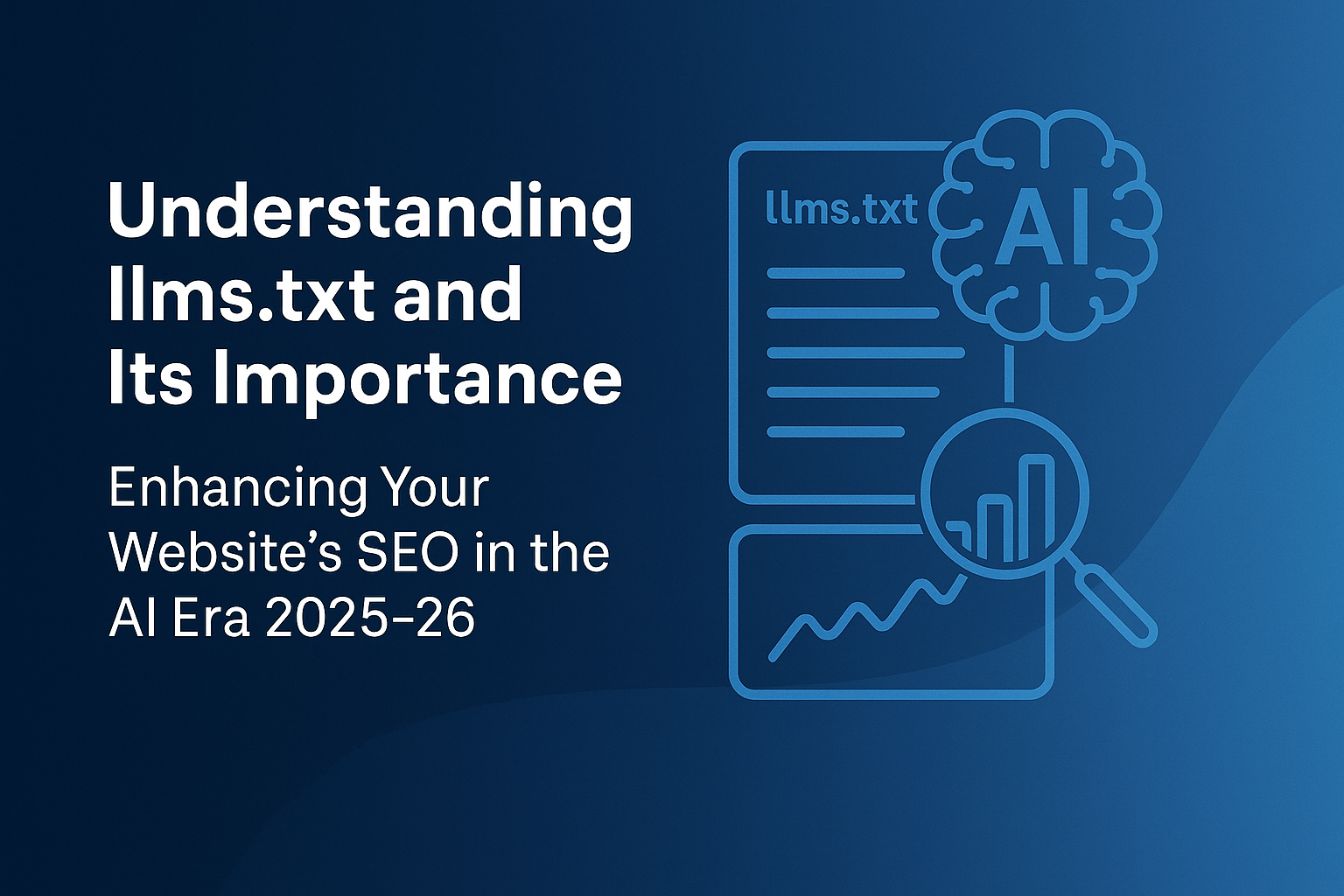
Enhancing Your Website’s SEO in the AI Era 2025-26
In the rapidly evolving digital landscape, staying ahead in search engine optimization (SEO) requires adapting to new technologies. One such advancement is the introduction of the llms.txt file—a tool designed to improve how large language models (LLMs) interact with your website.
What is llms.txt?
The llms.txt file is a plain text document placed in the root directory of your website. Its primary purpose is to guide LLMs, such as ChatGPT or Google’s AI models, by highlighting the most relevant and valuable content on your site. Unlike traditional files like robots.txt or sitemap.xml, which cater to search engine crawlers, llms.txt is specifically tailored for AI models that process and generate human-like text.
By providing a structured list of important URLs—such as product pages, FAQs, or detailed guides—llms.txt helps LLMs understand and represent your content more accurately in AI-driven search results and responses.
Why is llms.txt Important for SEO?
As AI models become increasingly integrated into search engines and digital assistants, ensuring they access and interpret your content correctly is vital. Here’s why llms.txt matters:
- Enhanced Content Visibility: By directing LLMs to your key content, you increase the chances of your information appearing in AI-generated answers, summaries, and search snippets.
- Improved Content Accuracy: Providing clear guidance helps prevent misinterpretation of your content, ensuring that AI models convey accurate information about your products or services.
- Competitive Advantage: Early adoption of llms.txt can position your website ahead of competitors by optimizing how AI models perceive and present your content.
- Future-Proofing Your SEO Strategy: As AI continues to shape the digital landscape, integrating llms.txt into your SEO practices prepares your website for upcoming changes in search behavior and technology.
llms.txt vs robots.txt vs sitemap.xml
| Feature | llms.txt |
robots.txt |
sitemap.xml |
|---|---|---|---|
| Purpose | Guides large language models (LLMs) | Tells search engine bots what to crawl or avoid | Maps website structure for search engine indexing |
| Used By | AI models like ChatGPT, Google Gemini, etc. | Search engine crawlers (Googlebot, Bingbot) | Search engine crawlers |
| File Location | Root directory (yourdomain.com/llms.txt) |
Root directory (yourdomain.com/robots.txt) |
Root directory (yourdomain.com/sitemap.xml) |
| Content Format | List of important URLs (text) | Directives like Disallow: or Allow: |
XML file with structured URL data |
| Focus | Content relevance and accuracy for AI outputs | Indexing control | Discoverability of content |
| Updated How Often? | Regularly, based on new or updated content | Occasionally, when site structure or rules change | Automatically or when content changes |
Implementing llms.txt on Your Website
Creating and deploying an llms.txt file involves a few straightforward steps:
- Identify Key Content: Determine which pages on your website are most valuable to users and should be highlighted to AI models.
- Create the llms.txt File: Using a text editor, list the URLs of your key content in a plain text file named
llms.txt. - Place the File in Your Root Directory: Upload the llms.txt file to the root directory of your website so that it is accessible at
https://www.yourwebsite.com/.llms.txt - Regularly Update the File: As your website evolves, ensure that the llms.txt file reflects the most current and relevant content.
Best Practices for llms.txt
To maximize the effectiveness of your llms.txt file:
- Use Clear and Descriptive URLs: Ensure that the listed URLs are self-explanatory and lead directly to valuable content.
- Avoid Duplicate Content: List unique pages to prevent redundancy and confusion for AI models.
- Monitor AI Interactions: Stay informed about how AI models are accessing and using your content, and adjust your llms.txt file accordingly.
FAQs
What is llms.txt and how does it differ from robots.txt or sitemap.xml?
llms.txt is a plain text file placed in your website’s root directory to help large language models (LLMs), like ChatGPT or Google’s AI, identify your most valuable content. Unlike robots.txt (which controls crawler access) or sitemap.xml (which maps out your site structure for search engines), llms.txt specifically guides AI models in better understanding and representing your content in AI-generated results.
Why should I include an llms.txt file on my website?
Including an llms.txt file helps AI models better index and understand your content, increasing its visibility in AI-generated search results, summaries, and featured answers. It can lead to higher accuracy, more traffic, and improved user trust—especially as AI becomes more integrated into search engines.
What type of content should I list in llms.txt?
List high-value pages like detailed blog posts, FAQs, product pages, how-to guides, and services that best represent your expertise. Avoid duplicate or low-quality pages to ensure AI models prioritize the most useful and relevant parts of your site.
How often should I update my llms.txt file?
You should update your llms.txt file regularly—especially after publishing new key content or restructuring your website. This ensures AI models always access your most up-to-date and relevant pages.
Conclusion
Incorporating an llms.txt file into your website’s structure is a proactive step toward optimizing your content for the AI-driven future of search. By guiding large language models to your most important content, you enhance visibility, accuracy, and competitiveness in an increasingly AI-integrated digital environment.
For businesses like Clixpert, embracing tools like llms.txt not only improves SEO performance but also demonstrates a commitment to innovation and user-centric content delivery.



